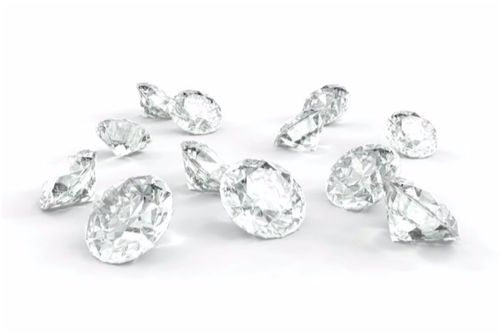It’s April and Here’s Why Diamond is Your Birthstone
Diamonds: A girl’s best friend. Infamously expensive and the height of luxury. The universal symbol of everlasting love. Liz Taylor owned the first documented million-dollar valued stone, and Lucy was in the sky with them.
For those fortunate enough to be born in April, the diamond is your birthstone. Legend has it diamonds have a number of attributes, including:
Healing powers
Ability to ward off evil
Protect against the plague
Bring the wearer longevity, happiness, beauty and strength
History of Diamond
One ancient theory posited that diamonds were formed from lightning bolts hitting the earth. As evidence of this way of thinking, in Sanskrit, a diamond is called vajra, which also means lightning, and in Hindu mythology, vajra was the weapon of Indra, the king of gods. Only the best for the king of kings.
So, are those born in April endowed with special powers in connection to their birthstone? Probably not, but that belief is what fueled the tradition of the birthstone. It is said that a breastplate belonging to a priest in biblical times was adorned with 12 gems — each corresponding to a tribe of Israel. Later it was believed to be representative of the signs of the zodiac.
It was also believed that by wearing a stone during its given month, good fortune would be created. With this as background, the (American) National Association of Jewelers (now known as Jewelers of America) created the official birthstone list back in 1912. And while it remains a mystery why specific stones were chosen for each month, it seems likely that whoever had final say on the list was born in April.
The Zodiac and Diamond Connection
Zodiac-wise, an April birthday means a person is either an Aries or a Taurus. Aries is a fire sign and Taurus is an earth sign, which just happens to coincide with what it takes to create a diamond. Both signs are known for being strong- willed, and Aries are known for being passionate and confident. Taurus people are said to be devoted and stable long-term partners, in both business and love. These traits all align with perceived properties of diamonds, so while there is no confirmation that zodiac signs actually influenced the birthstone list, diamond for April is certainly a brilliant fit.
The history of the diamond started more than a billion years ago, when most diamonds were first formed, deep within the Earth’s mantle. Composed of carbon and the hardest substance on earth, a diamond can only be born in high temperature and pressure conditions that exist at least 100 miles below the Earth’s surface, or by mimicking that environment in a laboratory. (For more on laboratory-grown diamonds, read our post from March of this year, Understanding Laboratory-grown Diamonds.)
As far back as the first century A.D., Roman author Pliny was, some could argue, the first gemologist. He had accurately detailed notes of diamond’s structure and he had ideas for how its strength — 58 times anything existing in nature — could be used for industrial advances.
Where Diamonds are Found
The world’s wider obsession with diamonds began in the rivers of India as early as the fourth century B.C., according to historians. There was a limited supply and they were only available to the most affluent. By the 1400s, diamonds had made their way onto the necks, ears and wrists of Europe’s wealthiest citizens.
Gold miners in Brazil began to discover diamonds in the 1700s — fortunately for them around the same time India’s diamond supply was declining. While the diamond market was changing hands, so was political power across the world. Ruling monarchies were out, taking the biggest customer base for diamonds with them.
The basis for our modern diamond market began in the 1800s, when the United States and Western Europe were seeing increasing wealth in their populations. Diamonds were discovered in South Africa in 1866, and by 1900, De Beers controlled about 90 percent of the world’s production of rough diamonds, with all of their mines in South Africa. Diamond mining then expanded again in 1985 and 2000, with the discovery of sources in Australia and Northern Canada, respectively.
Understanding Diamond Quality
The quality of a cut diamond can be determined using the Gemological Institute of America’s 4Cs:
Clarity: Clarity grades the number and appearance of any blemishes or defects in a diamond.
Color: Color assesses the color of a diamond — the less color it possesses, the higher it scores.
Raw diamonds
Cut: Cut measures how the proportions of a diamond’s facets interact with light.
Carat weight: Carat weight determines how much a diamond in worth.
A high-quality one carat diamond could be worth as much as a medium-quality diamond triple its size, due to the rarity of larger diamonds. As American screen icon Mae West once said, “I never worry about diets. The only carrots that interest me are the number you get in a diamond.”
Care and Cleaning of Your Diamond Jewelry
A kiss on the hand may be quite continental, but there’s a better way to care for your best friend. If you are fortunate enough to own a precious and purportedly powerful diamond, take care of it properly. Here at Shmukler Design, we suggest cleaning your diamond jewelry with warm water and a mild soap on a weekly basis. After drying it with a fine cloth, gently scrub with a toothbrush dedicated to jewelry cleaning to remove excess dirt and reach every facet so it shines like the magnificent marvel it is. We also recommend having the setting of your diamonds examined by a professional jeweler periodically to maintain their beauty and integrity for years to come.
For more information about diamonds — or how to create a setting that makes them stand out and sparkle — give us a call!


